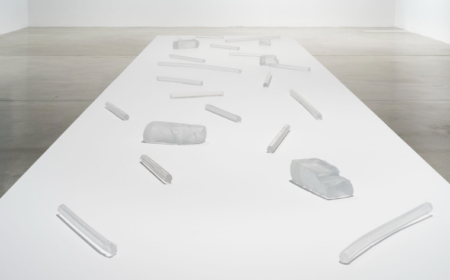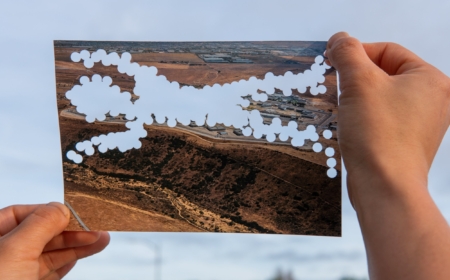Art As a Radical Tool for Realizing Abolition
How a growing collective of musicians, dancers, playwrights, and visual artists are using their practices to shift the narrative around the U.S. criminal legal system.
By Abigail Glasgow
Published August 17, 2023
On January 8, 2020, 700 men stood with their fists in the air at Louisiana State Penitentiary’s chapel. Liza Jessie Peterson had been performing her one-woman show The Peculiar Patriot, about a friend visiting an incarcerated loved one, when the officers abruptly shut it down, citing an “emergency.” For her premature curtain call, Peterson raised her hand, and the audience quickly followed suit. “The performance electrified the men,” she says. And eventually, it politicized their loved ones. With the guidance of Voice of the Experienced—a grassroots organization dedicated to restoring voting power for communities impacted by incarceration—the incarcerated residents began calling their families and friends, encouraging them to vote for candidates tackling the injustices of the criminal legal system. Since the airing of Peterson’s play, and following the election of progressive judges, a sheriff, and even a prosecutor, over 400 men have been released from the prison, far surpassing the one or two, on average, annual releases that occurred prior.
A little over two years earlier, in the fall of 2017, organizers and artists Patrisse Cullors and C. Sweet-Coll orchestrated two public drops of over 188 jail beds across L.A. County to stop its $3.5 billion jail expansion plan. By repurposing the beds as artwork, the activation shed light on how budgets and briefs often employ jail bed counts in lieu of the human beings occupying them. “It was a powerful moment where art became this public action,” says Cullors, reflecting on how the work kick-started a larger initiative, Justice LA, and succeeded in stopping the jail’s construction.
An hour away and a year earlier, incarcerated resident Major Bunton and his colleagues from the Actors’ Gang Prison Project—a theater arts program started by actor Sabra Williams as an emotional processing outlet for those inside—approached the sergeant at Avenal State Prison. Having built a bond through theater that disrupted racialized prison politics, they wanted to perform a play for the entire yard. After demonstrating their collective vulnerability onstage, the troupe got a standing ovation. “It changed the whole culture,” Bunton says, “and everyone started asking if they could join the class.” Since his release, Bunton has joined Creative Acts—an organization co-founded by Williams, building on her previous work—as director of programming. For Bunton, his “experience and willingness to come into this space opened up so many doors of opportunities.”
Art As Building Abolition and Revisiting History
Peterson, Cullors, Sweet-Coll, and Bunton occupy the ever-evolving space of artists whose work serves as a tool in abolishing the United States’ criminal legal system. Instead of punishment, “abolition asks us to cultivate a culture of care,” Cullors says. While it’s difficult to summarize a centuries-long movement, abolitionists contend that repairing harm requires assessing the root causes of that harm, such as poverty or mental health struggles, and responding with tools other than prisons and jails—e.g., mental health care, gainful employment, community accountability, substance abuse support, and whatever other resources are needed to restore justice for all parties. And when it comes to reimagining a world without prisons, who better to visualize an abolitionist present and future, alternatives to incarceration, and other solutions outside of punishment than those who have assumed creativity as their life’ work?
“Artists have the tools and superpower to imagine and give form to the things we cannot see,” says Elizabeth Alexander, the poet, Black studies educator, and current president of the Mellon Foundation. The philanthropy recently launched “Imagining Freedom,” an initiative dedicated to artists and advocates whose work responds directly to the criminal legal system. Alexander notes that that artists not only visualize what is unseen, but also “counter the hundreds-year-old propaganda that has us thinking that this country was not built on stolen land from stolen labor.”
Alexander is right. Undoing an archaic system whose foundation stems from slavery and convict leasing—the aftermath of slavery that permitted free but “legal” labor from Black folks who broke Black codes—takes radical vision. The tendency to punish is apparently so embedded in our human nature, we’ve nearly convinced ourselves it is synonymous with what it means to be human. We believe detention creates a more disciplined student. That a slap on the wrist builds character. And, somehow, that separating human beings from their families, placing them in cages and shackles, providing them with food devoid of nutrition, depriving them of adequate mental and physical health care, requiring they pay to communicate with the outside world we’ve taken from them, and, in many cases, withholding their access to everything from education to sunlight ensures societal safety.
Instead, art pushes us to consider a world where, in the words of Angela Davis (in her book Are Prisons Obsolete?), “prison no longer serves as our major anchor.”
“Art doesn’t really tell you what’s right or wrong,” says Brianna Mims, the artist and dancer behind a version of the aforementioned #jailbeddrop and creator of Uncle Ronnie’s Room. “Dance, in its improvisation and experimentation, teaches me so much about abolition and gives me a great appreciation for possibilities within the unknown.” After all, art is the ultimate Trojan horse. One minute you’re watching Mims dance—the next, you’re learning about how the criminal legal system is a full-blown moneymaking industry.
And whether they identify as abolitionists, advocates for alternatives to incarceration, or proponents of decarceration, the collective of artists determined to shift our reliance on carceral punishment through their media has become even more visible over the past few years. Brick by brick, they are—in the words of the Art for Justice Fund’s Helena Huang—“changing the weather … so that there’s more appetite and openness to systemic change.”
Art As Orchestrating Abolition, Decarceration, and Community
“If art wasn’t the right tool [for social impact], it wouldn’t be so underfunded, so undervalued, so ignored and misunderstood.” This is jackie sumell, the artist behind Growing Abolition and Solitary Gardens, both of which incorporate the visions and recipes of people in solitary confinement into outside gardens and medicine. Knowing the power of art in the movement to end mass incarceration, Agnes Gund launched the Art for Justice Fund in 2017 with the $100 million proceeds from selling a Roy Lichtenstein, ensuring a run of six years and over 200 grantees. A4J has planted seeds all over the country, from murals protesting putting kids in cages (strategically facing coffee shops frequented by Virginia legislators) to sumell’s Prisoner’s Apothecarts (which offer the aforementioned herbs and medicine for free to communities predominantly impacted by incarceration). In creating what Huang justifiably calls “a rich and robust ecosystem” of artists, many of whom have lived experience, A4J has continued the legacy of those who came before them while creating a blueprint for other organizations to do the same. In fact, with the sunsetting of the fund this summer, A4J’s team plans to pass along the group’s active listserv to the Center for Art and Advocacy, the latest decarceration venture from grantee Jesse Krimes, who recently joined Jack Shainman Gallery. “Until we saw [grantees] coming together,” Huang says, “we didn’t think there would be this chemical reaction, this alchemy.”
A4J is not alone in its community organizing of artists. James “Yaya” Hough, also an A4J grantee, says that in his 27 years incarcerated, art “provided a shady spot in a hellish place.” As he developed his solo drawing practice inside, he saw that budding activist groups needed to recruit artists for various initiatives. He describes making graphic illustrations for program pamphlets, knowing men inside would mimic his drawings on inside walls or keep them even when they were transferred to other facilities. “We were the messengers, the broadcasters,” he says—and, in some cases, a threat to officers “because of [the art’s] ability to communicate a mass message.” From leading art therapy sessions to designing flyers about antiviolence work, Hough witnessed how his and others’ art “linked groups together, ensuring our survival, but at the same time, creating shared resources and opportunities.”
Comparably, three years into launching their multimedia initiative Visualizing Abolition, the University of California Santa Cruz’s Professor Gina Dent and Dr. Rachel Nelson have built a consortium of musicians, scholars, and artists whose relationships to the criminal legal system vary. “We intentionally have embraced the form of abolitionist thinking that allows for a wide spectrum [of artists],” Dent says. “We see that as part of our practice. The movement for abolition is led by those inside of prisons and most impacted by the criminal legal system, and there is also a vibrant and growing consortium of people outside of prisons creatively imagining new worlds—our programming highlights this continuum.”
Dent, who has been a leader in the resistance movement for decades, is speaking to the range of perspectives that constitute anti-prison work—because, unlike movements whose organizers look the same and come from the same demographic (I won’t name names), abolition has many faces. Visualizing Abolition channels these diverse perspectives into exhibitions, panels, and, as of this past spring, a certificate program featuring a course taught by Nelson and Dent for UC Santa Cruz students. “Abolition is long-term, it’s a historical struggle, and it doesn’t go away until everybody’s free,” Nelson says of the consistent questions and conversations that come up doing this work daily. “Artists help us see both the histories and the joy that can be taken in joining part of this struggle.”
Art As Practicing Abolition
In a movement that can often be reduced to its darkest symbols—chains, cages, and orange jumpsuits, to name a few—this ability of artists to create spaces of levity and healing is especially pertinent. And for the artist collective Crenshaw Dairy Mart, this looks like the Abolition Pod. Inspired by the community fridge movement in Inglewood, the team wanted to build a safe structure that would grow food for neighbors and foster conversations around abolitionist praxis. First located in the Museum of Contemporary Art’s parking lot, the pod now sits next to a 90-day transitional housing facility, the Hilda L. Solis Care First Village.
The Abolitionist Pod allows the CDM team and the larger community to “practice abolition in real time,” says co-founder Cullors. He says CDM members underscored in their contract with the museum that they would not permit use of law enforcement to protect the art. “When they asked, ‘Well, what happens if someone harms the art?’ we said, ‘We believe we can fix that. But we can’t bring someone’s life back.’”
For Richie Reseda, abolition has unfolded in real time through music. He specifically recalls when grassroots organization Barrios Unidos would come into the prison where he was incarcerated to put on concerts and events tied to various holidays. “We had a cultural space to experience their instruments, their music,” he says. “Those were some of the most beautiful and healing days that I had inside. In those moments, I was free.” Now an advocate outside, Reseda commits to creating similar spaces and implementing abolition through his production company, Question Culture. At a recent event hosted in Los Angeles’s Leimert Park for one of the company’s artists, JJ’88, all attendees were required to read and confirm they understood a safety agreement, which Reseda presented again ahead of the performance. Instead of bringing law enforcement into the space, he asked select audience members if they would agree to support him in holding people accountable should they not respect the agreement. “Now we have an abolitionist container,” Reseda says, “and those 150 concertgoers left that experience seeing an alternative to policing for safety.”
Art As Humanizing Abolition
Poet Keith LaMar heard Samora Pinderhughes’s abolitionist album The Transformations Suite while on death row in Ohio. Music brought the two men together, and in their correspondence, Pinderhughes says, “it was clear pretty quickly that [Keith] had important messages to send to people”—among them the fact that he has maintained his innocence for over three decades. Alongside their musical collaborations, including a song slated to come out this fall, Pinderhughes’s organization the Healing Project has been working since February in conjunction with LaMar’s legal and advocacy teams on his fight for freedom. This month, LaMar’s original execution date, November 16 of this year, was pushed back to January 13, 2027.
Using the momentum from this reprieve, the Healing Project has launched Letters to Keith, a campaign calling for LaMar’s exoneration and release. Pinderhughes seeks to center the actual human being who is LaMar, something the Healing Project often does by integrating poems and reflections from those inside into musical performances. “So often people inside are reduced to objects, and at the very best, it’s about their pain,” Pinderhughes says. “A big part of my mission is to show their sweetness, their brilliance, their creativity, their wisdom, and the tools they have that we could all learn from.”
Far too often, the humanity of those inside gets shoved aside—or supplanted by numbers—in discussions about the criminal legal system. Two million currently incarcerated in the United States. 1,571 executed by the state since 1973. Four dead this year alone on Rikers Island. $29 million daily out of taxpayers’ pockets to fund the New York Police Department. “When we’re dealing with things like budgets, numbers, or data, there’s such a profound limit to what these documents can communicate,” says Daveen Trentman, co-founder of the Soze Agency and co-curator of the last spring’s pop-up exhibit at the Museum of Broken Windows, a project of the New York Civil Liberties Union. (The name refers to the unfounded theory–turned–harmful practice that police could “prevent violent crime by responding aggressively to low-level crimes,” says the NYCLU’s Johanna Miller.) While not an abolitionist organization, the NYCLU has historically focused on decarceration work, and this most recent show, “29 Million Dreams,” focused on how the mayor could reallocate NYPD funds to other departments.
“Not everyone is going to read a brief,” co-curator and artist Terrick Gutierrez says, “so the exhibition presented large texts and imagery—simple and straightforward—as a starting point for those who may not be policy-oriented.” Russell Craig’s portrait of Breonna Taylor hung on raw canvas, paint still dripping down from her features. An excerpt from Mitchell S. Jackson’s Pulitzer Prize– and National Magazine Award–winning Runner’s World story “Twelve Minutes and a Life” appeared alongside it: “Ahmaud Marquez Arbery was more than a viral video … a hashtag … a headline.” That, Trentman says, is when you connect to “this human who was a consequence of choices that we made in regards to policy and budget.” And that is when you start to consider how something like redistributing funds could help realize abolition.
At the back of this particular show, a floor-to-ceiling chandelier—a large-scale installation titled End to End Burners—caught many of our eyes. Artist Marcus Manganni spent a full year hand-making the 1,500 individual shivs—clear acrylic toothbrush heads and broken razor blades—that made up an architectural feat playing with light.
“Making each one was a way to personally confront the violence in a for-profit system and a means to reclaim my life,” Manganni says of the process. He first started working with light in his art while in solitary confinement, when a glass brick would refract sunlight into his cell for about 30 minutes a day. He started sun mapping and eventually would create geometric shapes out of washed and smoothed-out reflective potato-chip bag liners to contort beams of light. During this time, Manganni says he was “exploring my social confinement and having a conversation with the outside world.” On the outside, Manganni continues to use light as an inviting starting point for conversations about the prison-industrial complex. “My art provides a way for the general public to be attracted to something they normally wouldn’t be through abstraction.”
Art As Realizing Abolition
The number of artists dedicated to abolishing the criminal legal system or ending mass incarceration is growing exponentially, thanks to the attention of conscious funders, fellow artists with lived experience seeing their peers in positions of leadership, and the overall increased visibility of structural violence in the United States. Occupying a range of spaces from locally impacted communities and carceral facilities to institutions like MoMA PS1 and the Guggenheim, abolitionist art is, as Gina Dent says, “allowing people to be excited again, to feel alive and together in this world.” It is resensitizing a society that is understandably discouraged—by censorship, by revoked rights, by state- and police-sanctioned murder. But ultimately, art is waking people up by tapping into their feelings. Because, as Richie Reseda puts it, “You can change ideas with conversation. You can change actions with policy. But you can only change feelings with art.”
Image: This feature is part of ART & ABOLITION, a series examining art as a tool for reimagining alternatives to incarceration and as a means of rehabilitation for systems-impacted individuals.
Please visit Harpers Bazaar to read the full article.




